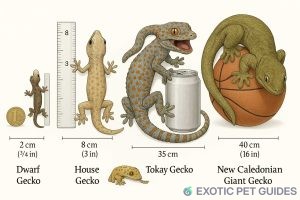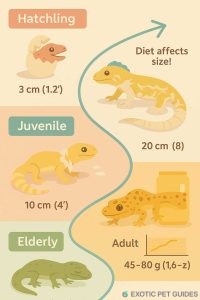From Tiny Dwarfs to Giant Lizards—A Look at Gecko Size Across Species
When people hear “gecko,” they often think of a small, chirping lizard clinging to a wall. But geckos are an incredibly diverse group of reptiles, with over 1,500 species found on nearly every continent. And when it comes to size, the range is wildly impressive—from tiny thumb-sized micro-geckos to foot-long, jungle-dwelling giants.
So just how big can geckos get? Let’s explore the fascinating world of gecko sizes—from the smallest to the largest, and what influences their growth.

🧬 Gecko Size Basics: What Determines Growth?
Several factors affect how big a gecko can grow:
- Species genetics – Different species have vastly different size ranges
- Sex – Males and females often differ in size
- Diet and nutrition – Poor diet can stunt growth
- Enclosure and husbandry – Space, temperature, and humidity all play roles
- Age – Most geckos take 6 months to 2 years to reach adult size
📏 The Smallest Geckos in the World
🐜 Jaragua Dwarf Gecko (Sphaerodactylus ariasae)
- Length: ~1.6 cm (0.63 inches)
- Weight: Less than a paperclip
- Habitat: Found only in the Dominican Republic and Haiti
- Fun Fact: It’s the smallest known reptile on Earth!
These tiny geckos are barely the size of a Tic Tac—and so delicate they’re rarely kept as pets.
🐾 Popular Pet Geckos and Their Sizes
🐆 Leopard Gecko (Eublepharis macularius)
- Length: 7–10 inches
- Weight: 45–90 grams
- Growth Time: 12–18 months
- Note: One of the most common pet geckos and fairly robust in size
🌿 Crested Gecko (Correlophus ciliatus)
- Length: 8–10 inches (including tail)
- Weight: 35–55 grams
- Fun Fact: Their prehensile tails and sticky toes make them great climbers
💚 Day Gecko (Phelsuma species)
- Length: 4–12 inches (depending on species)
- Example: Giant Day Gecko (Phelsuma grandis) can reach 11–12 inches
- Note: Arboreal and highly active, needing vertical space
🗣️ The Giant of the Gecko World
🔊 Tokay Gecko (Gekko gecko)
- Length: 10–14 inches (some exceed 15 inches!)
- Weight: 120–200+ grams
- Habitat: Southeast Asia, rainforests, and urban areas
- Personality: Loud, bold, and not afraid to bite
The Tokay Gecko is the second-largest known gecko species and easily one of the most striking—both in looks and behavior.
🦖 Honorable Mention: The New Caledonian Giant Gecko
👑 Leachianus Gecko (Rhacodactylus leachianus)
- Length: 12–17 inches (tail included)
- Weight: Up to 400+ grams
- Nickname: “Leachie”
- Fun Fact: This is the largest living gecko species on the planet!
Leachianus Geckos are native to New Caledonia and are prized by breeders and advanced reptile hobbyists for their size and prehistoric appearance.
🐣 Baby vs. Adult Geckos
Hatchling geckos are tiny compared to their adult forms:
- Leopard gecko hatchlings: ~3 inches
- Crested gecko hatchlings: ~2 inches
- Tokay gecko hatchlings: ~4 inches
It can take anywhere from 6 months to 2 years for geckos to reach full size depending on the species and care provided.

🧼 Does Captivity Affect Gecko Size?
Yes — to a degree.
While genetics determine max size, geckos kept in poor conditions (cold, cramped, malnourished) may suffer from stunted growth. Conversely, a healthy, enriched environment can help them reach their full potential.
🟢 Tip: Provide proper lighting, heating, humidity, and diet tailored to your gecko species to promote healthy growth.
📊 Quick Gecko Size Comparison Chart
| Species | Average Length | Pet-Friendly? |
|---|---|---|
| Jaragua Dwarf Gecko | 0.6 in | No (too delicate) |
| House Gecko (Hemidactylus) | 3–5 in | Yes (some species) |
| Leopard Gecko | 7–10 in | Yes ✅ |
| Crested Gecko | 8–10 in | Yes ✅ |
| Tokay Gecko | 10–14 in | Yes (experienced) |
| Leachianus Gecko | 12–17 in | Yes (advanced) |
🧠 Final Thoughts
Geckos come in an incredible range of sizes, from thumb-sized climbers to heavy-bodied giants. Whether you’re drawn to the charming little house gecko or the commanding presence of a Leachie, understanding their size helps you provide proper care — and sets realistic expectations for space and handling.
Remember: Big or small, every gecko deserves a habitat that matches its needs and allows it to grow to its full, healthy size.
